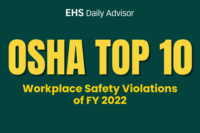Artco-Bell Corp., a Temple, Texas, school furnishings manufacturer, faces a $257,183 Occupational Safety and Health Administration (OSHA) fine after a worker sustained serious, permanent hand and arm injuries, the agency announced October 21. According to OSHA, the worker’s injuries could have been prevented had the employer installed required machine guards. Agency investigators learned that in […]
Latest Articles
EHSDA Song of the Week: Sick of Myself
Amazingly enough, October is winding down and we’re heading into the colder months, which means most areas will be inundated with respiratory diseases like influenza, RSV, and COVID. This week, EHS Daily Advisor wrote about indoor air quality and preparing for respiratory disease season, so the Song of the Week is Matthew Sweet’s power pop […]
Infographic: Meat and Poultry Worker Guidance
The Occupational Safety and Health Administration (OSHA) this month announced the release of new inspection guidance for animal slaughtering and processing facilities. Previous guidance applied to poultry establishments, but the updated guidance is intended to reduce injuries and illnesses resulting from occupational hazards in the meat processing industry. Here’s what you need to know about […]
EPA Proposes Updated Recommendations for Sustainable Products Purchasing
The EPA recently announced a proposed update to its Recommendations of Specifications, Standards, and Ecolabels for Federal Purchasing, which help federal government purchasers and other buyers use private sector standards and ecolabels to buy products that are more sustainable and climate-friendly and contain safer chemical ingredients. This update marks the first time in nearly 10 […]
EPA Orders Vermont to Improve NPDES Permitting Oversight
The EPA has put the state of Vermont on notice that it must make corrections to its administration of the federal National Pollutant Discharge Elimination System (NPDES) program or lose the authority altogether. In a letter dated September 6, 2024, the EPA Region 1 administrator informed Vermont authorities it had received a joint petition from […]
Featured Articles
Back to Basics: What is the OSHA Form 300 and How Do I Use It?
Back to Basics is a weekly feature that highlights important but possibly overlooked information that any EHS professional should know. This week, we take a look at the OSHA 300 log and how to use it. If you’ve ever questioned what to record on your OSHA Form 300, short for OSHA Log of Injuries and […]
Faces of EHS: 2023 Questions
Are you an environment, health, and safety (EHS) professional with something to contribute to your professional community? If so, we want to hear from you! Faces of EHS is our feature series where we profile leaders in the EHS industry, shining a light on their background, best practices, trends, and, most importantly, how they keep […]
Infographic: OSHA Top 10 List for FY 2022
The construction industry fall protection standard remains the Occupational Safety and Health Administration’s (OSHA) most frequently cited standard for the 12th year in a row, the agency announced on September 20. Patrick Kapust, acting director of OSHA’s Directorate of Enforcement Programs, presented a list of preliminary figures for fiscal year (FY) 2022—the fiscal year ends September […]
Featured Multimedia
Infographic: Meat and Poultry Worker Guidance
The Occupational Safety and Health Administration (OSHA) this month announced the release of new inspection guidance for animal slaughtering and processing facilities. Previous guidance applied to poultry establishments, but the updated guidance is intended to reduce injuries and illnesses resulting from occupational hazards in the meat processing industry. Here’s what you need to know about […]
EHSDA Shorts: How Do You Use Technology to Improve Safety Culture?
In this installment of EHSDA Shorts, Abby Ferri, President of the Ferri Group, explains how EHS professionals use technology to improve safety culture.









